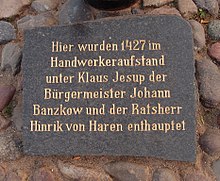Johann Bantzkow
Johann Bantzkow , also: Banskow, Bantscow , Bantschow or Bandschow , († November 18, 1427 in Wismar ) was a merchant and mayor of the Hanseatic city of Wismar.
Life
Johann Bantzkow belonged to a respected family of the Wismar patriciate . From 1410 it is in several Rezessen the Hanseatic named as envoy Council of his hometown.
Riots in Wismar
At this time, fights broke out. The craftsmen under the wool weaver Claus Jesup seized power and deposed the "Old Council", of which Bantzkow was a member; in its place they set up a 60 committee in 1409 . Although the "Old Council" succeeded temporarily in taking over government again in 1416, a large part of the population followed its policy with suspicion.
At the beginning of the 15th century, these inner-city riots are documented for almost all cities in northern Germany. There were similar power struggles between the craft offices against the long-distance trade merchants in the other Hanseatic cities. From 1408 onwards, a “New Council” made up of craftsmen and merchants had also ruled Lübeck until the old conditions were restored in 1416 under pressure from King Sigismund .
The war against Denmark
As early as 1410, the Wendish cities had been arguing militarily with Denmark over the privileges curtailed by Queen Margaret I. Under her successor Erik , the situation escalated because his policies resulted in monetary deterioration and trade restrictions. When Jordan Pleskow , the always mediating mayor of Lübeck , died in 1425 , open war broke out in October of the following year.
Together with his colleague, Councilor Hinrik van Haren , Bantzkow led the Wismar warships of the Hanseatic fleet in 1427 under the command of Lübeck's mayor Tidemann Steen . The fleet allegedly consisting of over 200 ships with several thousand crew members could not prevent the capture of cogs returning home with Baiensalz from France by Danish warships and also suffered two on July 11th in Strelasund off Rügen and on July 25th in Øresund off Copenhagen sensitive defeats; 36 Hanseatic ships, including 12 from Wismar, were conquered by the Danes.
Back in Wismar, van Haren and Bantzkow became victims of the popular anger instigated by Claus Jesup. Van Haren was immediately executed without a court judgment, and Bantzkow was sentenced to death. The reasoning for the judgment was roughly that this dispute, for which the mayors were responsible, had started exclusively in the interests of the patriciate and not in the interests of the city of Wismar and its citizens.
Tidemann Steen was also removed from office in Lübeck and put in chains. In Hamburg , the councilor Johann Kletze , who had commanded the troops of the Hanseatic League near Flensburg, was beheaded in January 1428 for his premature attack on the Duburg , which was contrary to the agreement . At the same time there were riots in Rostock and Stralsund .
The execution and the consequences
With the support of the City Council of Lübeck, Bantzkow's family was able to ensure that the death penalty was not carried out by wheeling , but by beheading with a sword, which is regarded as more honorable .
Since the beginning of the 14th century, the long-established Bantzkows in Wismar had an altar and a family crypt in the Wismar Chapel of St. Marien zu den Weiden . The executed mayor was buried in it.
At the same time, the patrician old council was removed again and the new council consisting of the rebels was recognized by Duchess Katharina , who reigned for her son Heinrich IV . Claus Jesup became mayor.
While the majority of the executioner's family fled to Lübeck, the eldest son, Johann Bantzkow, did not accept the execution of his father and got Emperor Sigismund to take care of the case. This imposed because of the two death sentences Reichsacht and Feme on Wismar and its citizens. The law was enforced by force of arms in 1430. The "old council" was solemnly reinstated. The family of the executed man received satisfaction and compensation, the other side was massively humiliated. The Bantzkow Atonement Chapel (also not preserved) was built as an atonement by the city .
The war with Denmark, which had cost Bantzkow his head, was continued by the Hanseatic cities beyond the low point of 1427 as a pirate war , in which they did not shy away from taking the support of the Vitalienbrüder . Only with the Peace of Vordingborg (1435) could the conflict be ended on conditions favorable to the Hanseatic League.
literature
- Antjekathrin Graßmann : Lübeckische Geschichte . Schmidt-Römhild, Lübeck 1997. ISBN 3-7950-3215-6
- Karl Ernst Hermann Krause: Bantscow, Johannes . In: Allgemeine Deutsche Biographie (ADB). Volume 2, Duncker & Humblot, Leipzig 1875, p. 42 f.
- Friedrich Schlie : The art and history monuments of the Grand Duchy of Mecklenburg-Schwerin. Volume 2: The district court districts of Wismar, Grevesmühlen, Rehna, Gadebusch and Schwerin. Bärensprungsche Hofbuchdruckerei, Schwerin 1898 (reprinted. Stock and Stein, Schwerin 1992, ISBN 3-910179-06-1 ).
Remarks
- ^ Antjekathrin Graßmann: Lübeckische Geschichte , p. 267
- ↑ Schlie, p. 167 ff.
- ↑ Schlie, p. 16 ff.
- ↑ Schlie, pp. 170 ff; Demolished around 1850.
| personal data | |
|---|---|
| SURNAME | Bantzkow, Johann |
| ALTERNATIVE NAMES | Banskow, Johann; Bantscow, Johann; Bantschow, Johann |
| BRIEF DESCRIPTION | German businessman and mayor of the Hanseatic city of Wismar |
| DATE OF BIRTH | 14th Century |
| DATE OF DEATH | November 18, 1427 |
| Place of death | Wismar |
